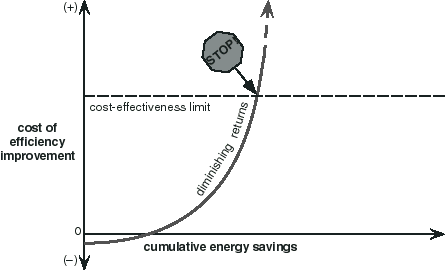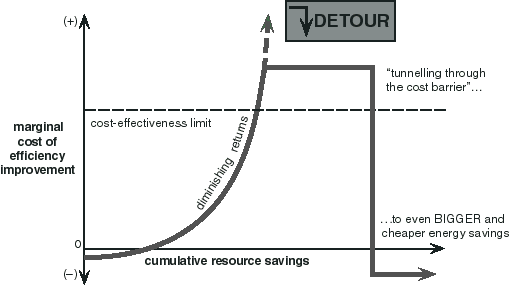Supply-Sided Environmentalism
Tax Cuts: a Virtuous Cycle
One of the most appealing things about supply-sided economics is that its proponents describe a feedback loop that transforms taxcuts, which are commonly thought of as “costing money”, into a source of new revenue (when measured through a larger economic base).
Energy Efficiency: a Virtuous Cycle
Though their isn’t anything “supply”-based about some environmentalist’s proposals for increased energy efficiency, is see an interesting parallel.
Increased Energy efficiency is normally thought of as an increasing cost to get a reduced benefit. Think of home insulation and improved windows.
Improved windows and more insulation cost more money; and as the desired energy savings increases, the cost increases, so as to be of diminishing value.

Like the supply siders, Amory Lovins looks for circumstances in which evaluations of individual actions within the traditional model don’t hold true for their effect on the system as a whole.
If Lovins were building a home, he would measure the future savings from the improved insulation and windows, but he would not stop there. Instead, he would analyze the effect of those savings on other parts of the
system.
Would the improved insulation and windows allow him to buy a smaller furnace and air conditioning unit? If so, he could take the savings from the air conditioning unit and furnace and plow it back into even better windows and insulation. Perhaps he would spend the money on more design, so that the south side of
the house would take better advantage of passive heating principles. Lovins would continue to iterate through this process, continually looking to pass on savings to other parts of the system.
Tunneling Through the Costs
Lovins describes his technique as “tunneling through the costs”, where he takes a graph for which cost-effectiveness has seemly been maximized, and demonstrates that higher energy saving can be advanced by eliminating one of the system’s assumptions, such as reducing or eliminating the heating or cooling system.

The New York Times ran a story recently about Passive Solar Houses in Germany in which the the need for a
furnace had been reduced or eliminated, freeing up money to be put to alternate uses.
Time magazine recently ran a cover story titled “America’s Untapped Energy Resource: Boosting Efficiency“.
It seems that the concept of reducing costs by optimizing an entire system would be attractive to many people; and unlike supply-sided economics, its effectiveness should be testable on the small scale.
Note:
For those who have an unfavorable view of “supply-sided” economics, I’m not trying to disparage Amory Lovin’s approach. The actual benefit of taxcuts can be debated. Rather, I think it would be interesting for those who like the idea of supply sided economics to consider the practicality of “Tunneling through” barriers to efficiency.